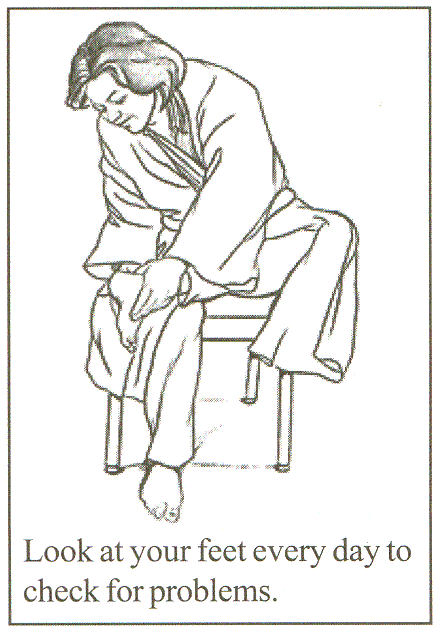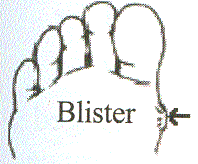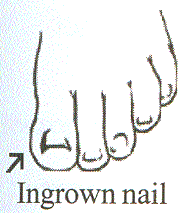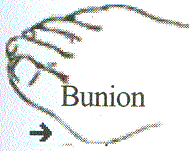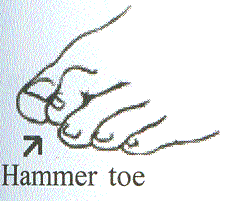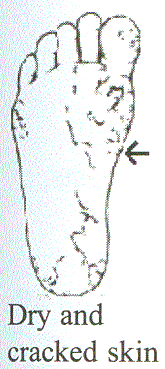19.
Patient Teaching
Keep Your Feet and Skin Healthy
 |
What are diabetes problems? |
 |
What should I do each day to stay
healthy with diabetes? |
 |
How can diabetes hurt my feet? |
 |
What can I do to take care of my
feet? |
 |
How can I get my doctor to help me
take care of my feet? |
 |
What are common diabetes foot
problems? |
 |
How can special shoes help my feet? |
 |
How can diabetes hurt my skin? |
 |
What can I do to take care of my
skin? |
 |
For more information |
|
What Are Diabetes Problem?
|
Too much sugar in the blood for a long time causes diabetes problems. This
high-blood sugar can damage many parts of the body, such as the heart, blood
vessels, and kidneys. Diabetes problems can be scary, but there is a lot you
can do to prevent them or slow them down.
|
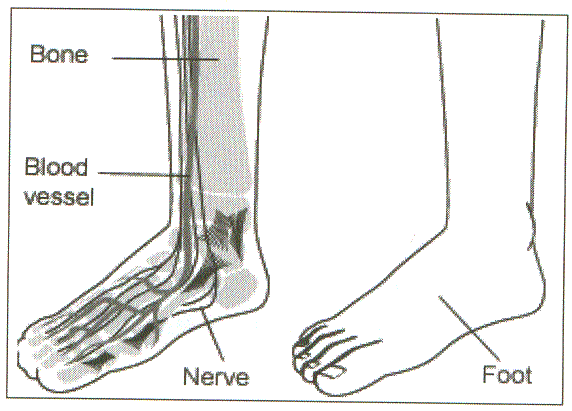 |
This chapter is about feet and skin problems caused by diabetes. You will
learn the things you can do each day and during each year to stay healthy and
prevent diabetes problems.
What Should I Do Each Day to Stay
Healthy With Diabetes
 |
Follow the healthy eating plan
that you and your doctor or dietitian have worked out. Eat your meals and
snacks at around the same times each day. |
 |
Be active a total of 30 minutes
most days. Ask your doctor what activities are best for you. |
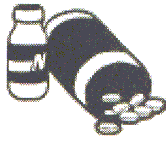 |
Take your diabetes medicine at
the same times each day. |
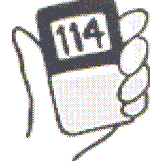 |
Check your blood sugar every day.
Each time you check your blood sugar, write the number in your record
book. Call your doctor if your numbers are too high or too low for 2 to 3
days. |
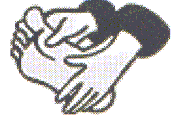 |
Check your feet every day for
cuts, blisters, sores, swelling, redness, or sore toenails. |
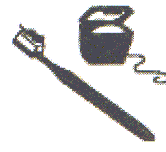 |
Brush and floss your teeth and
gums every day. |
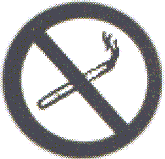 |
Donít smoke. |
How Can Diabetes Hurt
My Feet?
High blood sugar from diabetes causes two problems that can hurt your feet:
 |
Nerve damage. One problem is damage to nerves in your legs and
feet. With damaged nerves, you might not feel pain, heat, or cold in your
legs and feet. You might let a sore or cut on your foot get worse because
you do not know it is there. This lack of feeling is called diabetic
neuropathy (ne-ROP-uh-thee). It can lead to a large sore or infection. |
 |
Poor blood flow. The second problem happens when not enough
healthy blood flows to your legs and feet. Poor blood flow makes it hard for
a sore or infection to heal. This problem is called peripheral (puh-RIF-uh-rul)
vascular disease. Smoking when you have diabetes makes blood flow problems
much worse. |
These two problems can work together to cause a foot problem.
| For example, you get a blister from shoes that do not fit.
You do not feel the pain from the blister because you have nerve damage in your
foot. Next, the blister gets infected. If blood sugar is high, the extra sugar
feeds the germs. Germs grow and the infection gets worse. Poor blood flow to
your legs and feet can slow down healing. Once in a while a bad infection never
heals. The infection might cause gangrene (GANG-green). If a person has
gangrene, the skin and tissue around the sore die. The area becomes black and
smelly. |
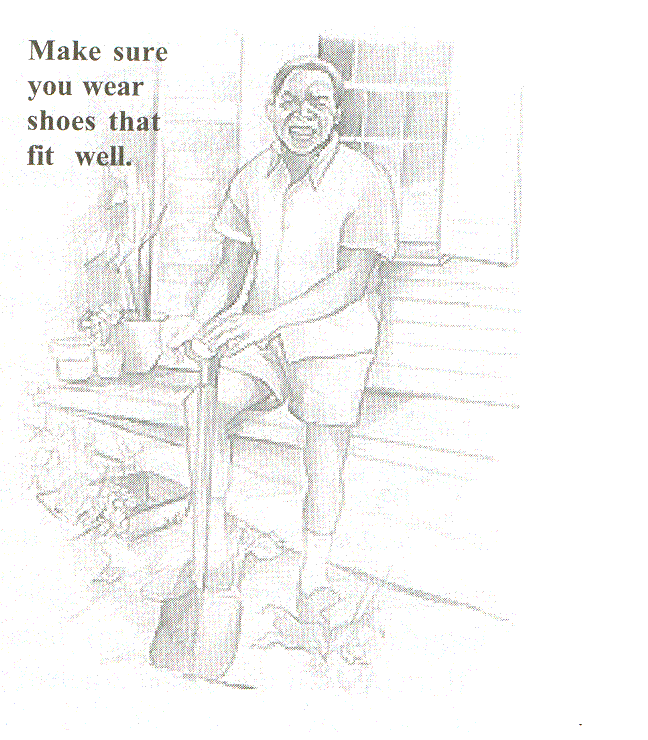 |
To keep gangrene from spreading, a doctor may have to do surgery to cut off a
toe, foot, or part of a leg. Cutting off a body part is called an amputation
(amp-yoo-TAY-shun).
What Can I Do to Take Care of My
Feet?
 |
If your skin is dry, rub lotion on your feet after you wash and dry
them. Do not put lotion between your toes. |
 |
File corns and calluses gently with an emery board or
pumice stone. Do this after your bath or shower.
Move the emery board in only one direction. |
 |
Cut your toenails once a week.
Cut toenails when they are soft from washing.Cut them to the shape of the toe
and not too short. Do not cut into the corners because you might cut the
skin. Sharp edges can make a sore that can get infected. File toenails with
an emery board. If you cannot cut your own toenails, ask someone who can or
go to a foot doctor. |
 |
Always wear shoes or slippers.
Never walk barefoot, even when you are at home. |
 |
Always wear socks or stockings.
Do not wear socks or knee-high stockings that are too tight below your knee. |
 |
Wear shoes that fit well. Buy shoes
made of canvas or leather. Shop for shoes at the
end of the day when your feet are bigger. Break in shoes slowly. Wear them 1
to 2 hours each day for the first 1 to 2 weeks. |
 |
Only use medicines your doctor tells you to use. |
|
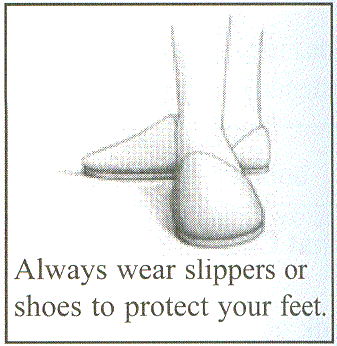 |
How Can I Get My Doctor To Take
Care of My Feet?
 |
Tell your doctor right away about any
foot problems. |
 |
Ask your doctor to look at your feet
at each diabetes checkup. To make sure your doctor checks your feet, take
off your shoes and socks before your doctor comes into the room. |
 |
Ask your doctor to check how well the nerves in your
feet sense feeling. |
|
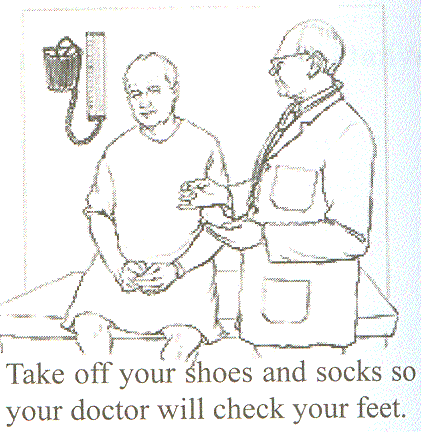 |
 |
Ask your doctor to check how well blood is flowing to your legs and
feet. |
 |
Ask your doctor to show you the best way to trim your toenails. Ask
what lotion or cream to use on your legs and feet. |
 |
If you cannot cut your toenails or you have a foot problem, ask your
doctor to send you to a foot doctor. A doctor who cares for feet is called a
podiatrist (puh-DY-uh-trist). |
What Are Common Diabetes Foot
Problem?
Anyone can have corns, blisters, and athleteís foot. If you have diabetes
and your blood sugar stays high, these foot problems can lead to infections.
All of these foot problems can be taken care of. Tell your
doctor about any foot problem as soon as you see it.
How Can Special Shoes Help My Feet?
Special shoes can be made to fit softly around your sore feet
or feet that have changed shape. These special shoes help protect your feet.
Medicare and other health insurance programs may pay for special shoes. Talk to
your doctor about how and where to get them.
How Can Diabetes Hurt My Skin?
Diabetes can hurt your skin in two ways:
-
If your blood sugar is high, your body loses fluid. With less fluid in
your body, your skin can get dry. Dry skin can be itchy, causing you to
scratch and make it sore. Also, dry skin can crack. Cracks allow germs to
enter and cause infection. If your blood sugar is high, the sugar feeds germs
and makes infections worse. Skin can get dry on your legs, feet, elbows, and
other places on your body.
-
Skin can also get dry because the nerves in your legs and feet do not
get the message to sweat. Sweating helps keep your skin soft and moist.
|
 |
|
What Can I Do to take Care of My
Skin?
 |
After you wash with a mild soap, make sure you rinse and dry yourself
well. Check places where water can hide, such as under the arms, under the
breasts, between the legs, and between the toes. |
 |
Keep your skin moist by washing with a mild soap and using lotion or
cream after you wash. |
 |
Keep your skin moist by using a lotion or cream after you wash. Ask
your doctor to suggest one. |
 |
Drink lots of fluids, such as water, to keep your skin moist and
healthy. |
 |
Wear all-cotton underwear. Cotton allows air to move around your body
better. |
 |
Look at your body after you wash. Make sure you have no dry, red, or
sore spots that might lead to an infection. |
 |
Tell your doctor about any skin problems. |
|
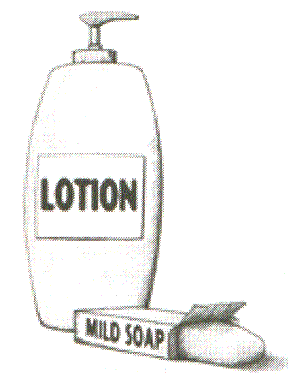 |
Source: National Institutes of Arthritis and Musculoskeletal and Skin
Diseases
National Institutes of Health
Take Care of Your Feet for
a Lifetime
You can take care of your feet!
Do you want to avoid serious foot problems that can
lead to a toe, foot, or leg amputation? Take Care of Your Feet for a
Lifetime tells you how. Itís all about taking good care of your
feet.
Foot care is very important for each person with
diabetes, but especially if you have:
 |
Loss of
feeling in your feet. |
 |
Changes
in the shape of your feet. |
 |
Foot
ulcers or sores that do not heal. |
Nerve damage can cause you to lose feeling in your
feet. You may not feel a pebble inside your sock that is causing a
sore. You may not feel a blister caused by poorly fitting shoes. Foot
injuries such as these can cause ulcers which may lead to amputation.
Keeping your blood glucose (sugar) in good control
and taking care of your feet every day can help you avoid serious foot
problems.
Use this guide to make your own plan for taking care
of your feet. Helpful tips make it easy! Share your plan with your
doctor and health-care team and get their help when you need it.
There is a lot you can do to prevent serious
problems with your feet. Hereís how.
1. Take care of your
diabetes.
|
ē Make healthy lifestyle choices to help keep
your blood glucose (sugar), blood pressure, and cholesterol close
to normal. Doing so may help prevent or delay diabetes-related
foot problems as well as eye and kidney disease.
ē Work with your health-care team to make a
diabetes plan that fits your lifestyle. The team may include your
doctor, a diabetes educator, a nurse, a dietitian, a foot care
doctor called a podiatrist (pah-DI-ah-trist), and other
specialists. This team will help you to:
|
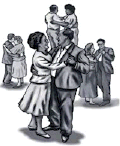 |
 |
Know when to get
checks of your A1C,* blood pressure, and cholesterol. |
 |
Know how and when to test your blood
glucose. |
 |
Take your medicines as prescribed. |
 |
Eat regular meals that contain a
variety of healthy, low-fat, high-fiber foods including fruits
and vegetables each day. |
 |
Get physical activity each day. |
 |
Stop smoking. |
 |
Follow your foot care plan. |
 |
Keep your doctorís visits and have
your feet, eyes, and kidneys checked at least once a year. Visit
your dentist twice a year. |
2. Check your feet every day.
|
You may have serious foot problems, but feel no pain.
Check your feet for cuts, sores, red spots, swelling, and
infected toenails. Find a time (evening is best) to check your
feet each day. Make checking your feet part of your every day
routine.
If you have trouble bending over to see your feet, use a
plastic mirror to help. You also can ask a family member or
caregiver to help you.
|
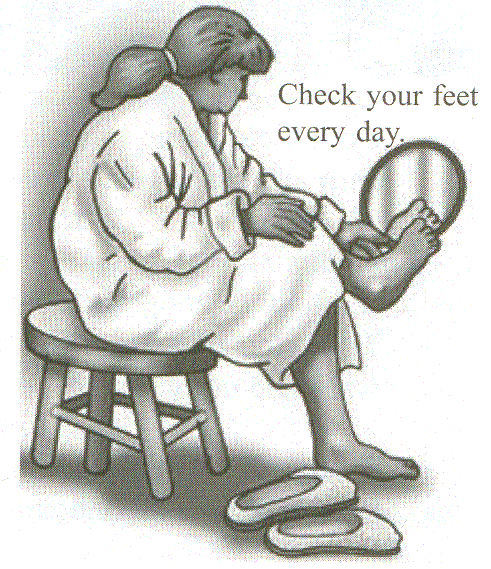 |
3. Wash your feet every day.
 |
Wash your feet in warm, not hot, water. Do
not soak your feet, because your skin will get dry. |
 |
Before bathing or showering, test the water
to make sure it is not too hot. You can use a thermometer (90į to
95į F is safe) or your elbow. |
 |
Dry your feet well. Be sure to dry between
your toes. Use talcum powder or cornstarch to keep the skin
between your toes dry. |
4. Keep the skin soft and smooth.
 |
Rub a thin coat of skin lotion, cream, or petroleum jelly on the tops
and bottoms of your feet. |
 |
Do not put lotion or cream between your toes, because this might
cause an infection. |
|
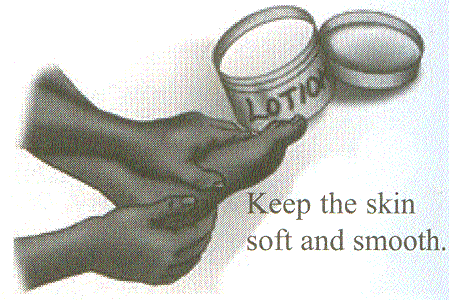 |
5. Smooth corns and calluses gently.
 |
If you have corns and calluses, check with your doctor
or foot care specialist about the best way to care for them. |
 |
If your doctor tells you to, use a pumice stone to
smooth corns and calluses after bathing or showering. A pumice stone is a
type of rock used to smooth the skin. Rub gently, only in one direction, to
avoid tearing the skin. |
|
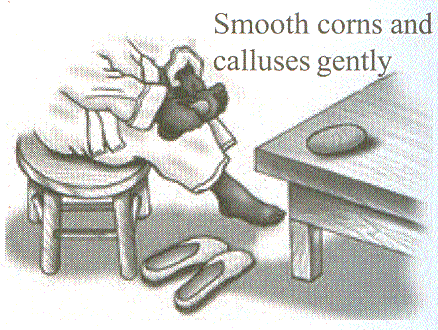 |
 | Do not cut corns and calluses. Donít use razor
blades, corn plasters, or liquid corn and callus removersĖ they can damage
your skin. |
6. Trim your toenails each week or when needed..
 |
Trim your toenails with clippers after you wash and
dry your feet. |
 |
Trim toenails straight across and smooth them with an
emery board or nail file. |
 |
Donít cut into the corners of the toenail. |
|
 |
 | If you canít see well, if your toenails are thick or
yellowed, or if your nails curve and grow into the skin, have a foot care
doctor trim them. |
7. Wear shoes and socks at all times.
 |
Wear shoes and socks at all times. Do not walk barefoot Ė not
even indoors Ėbecause it is easy to step on something and hurt your
feet. |
 |
Always wear socks, stockings, or nylons with your shoes to help
avoid blisters and sores. |
 |
Choose clean, lightly padded socks that fit well. Socks that have
no seams are best. |
|
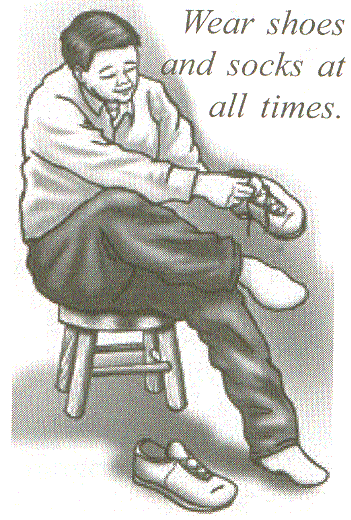 |
 |
Check the insides of your shoes before you put them on to be sure
the lining is smooth and that there are no objects in them. |
 |
Wear shoes that fit well and protect your feet. |
8. Protect your feet from hot and cold.
 |
Wear shoes at the beach or on hot pavement. |
 |
Put sunscreen on the top of your feet to prevent sunburn. |
 |
Keep your feet away from radiators and open fires. |
 |
Do not put hot water bottles or heating pads on your feet. |
|
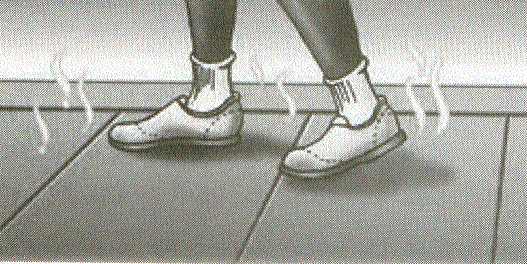
Protect your feet from hot and cold. |
 |
Wear socks at night if your feet get cold. Lined boots are good in
winter to keep your feet warm. |
 |
Check your feet often in cold weather to avoid frostbite. |
 |
Make sure to call your doctor right away if a cut,
sore, blister, or bruise on your foot does not begin to heal after one day. |
9. Keep the blood flowing to your feet.
 |
Put your feet up when you are sitting. |
 |
Wiggle your toes for 5 minutes, 2 or 3 times a day. Move your
ankles up and down and in and out to improve blood flow in your feet and
legs. |
 |
Donít cross your legs for long periods of time. |
|
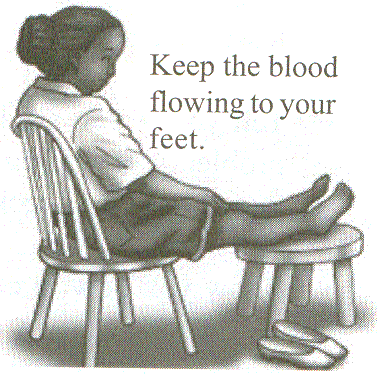 |
 |
Donít wear tight socks, elastic or rubber bands, or garters around your
legs. |
 |
Donít smoke. Smoking reduces blood flow to your feet. Ask for help
to stop smoking. |
 |
Work with your health-care team to control your A1C (blood glucose),
blood pressure and cholesterol. |
10. Be more active.
 |
Ask your doctor to help you plan a daily activity
program that is right for you. |
 |
Walking, dancing, swimming, and bicycling are good
forms of exercise that are easy on the feet. |
 |
Avoid activities that are hard on the feet, such as
running and jumping. |
|
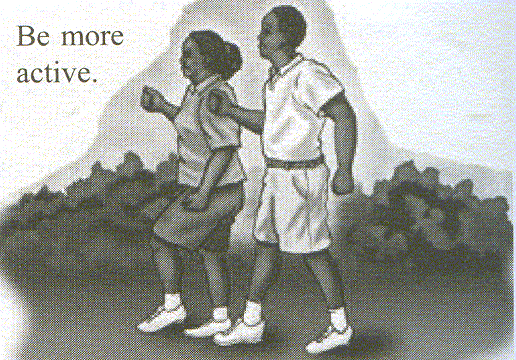 |
 |
Always include a short warm-up and cool-down period. |
 |
Wear athletic shoes that fit well and that provide
good support. |

|
Make sure to call your doctor right away if a cut, sore, blister, or bruise
on your foot does not begin to heal after one day.
|
11. Be sure to ask your doctor to
 |
Check the sense of feeling and pulses in your feet at least once a
year. |
 |
Tell you if you are likely to have serious foot problems. If you
have serious foot problems, your feet should be checked at every visit to
your doctor. |
 |
Show you how to care for your feet. |
|
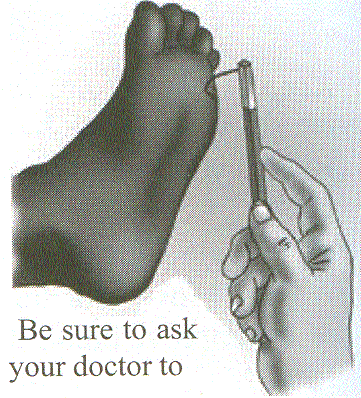 |
 |
Refer you to a foot care doctor if needed. |
 |
Decide if special shoes would help your feet stay healthy. |
12. Get started now.
 |
Begin taking good care of your feet today. |
 |
Set a time every day to check your feet. |
 |
Note the date of your next visit to the doctor. |
 |
Print out the foot care tip sheet* and put it on your bathroom or
bedroom wall or nightstand as a reminder. |
 |
Print out and complete the "To Do" list*. Get started
now. |
 |
Set a date for buying the things you need to take care
of your feet: nail clippers, pumice stone, emery board, skin lotion, talcum
powder, plastic mirror, socks, athletic shoes, and slippers. |
 |
Most important, stick with your foot care program ....
and give yourself a special treat such as a new pair of lightly padded socks
with no seams. You deserve it! |
 |
Make sure to call your doctor right away if a cut, sore, blister, or bruise
on your foot does not begin to heal after one day.
|
Tip For Proper Footwear
 |
Proper footwear is very important for preventing
serious foot problems. Athletic or walking shoes are good for daily wear.
They support your feet and allow them to "breathe." |
 |
Never wear vinyl or plastic shoes, because they donít
stretch or "breathe." |
 |
When buying shoes, make sure they are comfortable from
the start and have enough room for your toes. |
 |
Donít buy shoes with pointed toes or high heels.
They put too much pressure on your toes. |
Ask your doctor about Medicare or other insurance coverage for
special footwear.
 |
You may need special shoes or shoe inserts to prevent
serious foot problems. If you have Medicare Part B insurance, you may be
able to get some of the cost of special shoes or inserts paid for. Ask your
doctor whether you qualify for |
 |
1 pair of depth shoes* and 3 pairs of inserts, or |
 |
1 pair of custom molded shoes (including inserts) and
2 additional pairs of inserts. |
If you qualify for Medicare or other insurance coverage, your doctor or
podiatrist will tell you how to get your special shoes.
* Depth shoes look like athletic or walking shoes, but have more room in
them. The extra room allows for different shaped feet and toes, or for special
inserts made to fit your feet.
|
Steps For Preventing
Diabetes Foot Problems
1. Perform a comprehensive foot exam annually.
 |
Examine skin, hair, toenails, musculoskeletal structure, and
evaluate vascular status, and protective sensation. |
 |
Inspect footwear for proper fit, appropriate materials, foreign
objects, torn linings, and proper cushioning. |
|
Low Risk
All of the following:
|
High Risk
One or more of the following:
|
 |
Intact protective sensation |
 |
Pedal pulses present |
 |
No foot deformity |
 |
No current or prior foot ulcer |
 |
No amputation |
|
 |
Loss of protective sensation |
 |
Absent pedal pulses |
 |
Foot deformity. |
 |
History of foot ulcer |
 |
Prior amputation |
|
3. Document your findings in the medical record.
4. Counsel your patients and/or refer to a diabetes educator.
 |
Talk with your patients about their risk category. |
 |
Demonstrate self-care techniques. |
 |
Prescribe appropriate footwear. |
 |
Give positive feedback for proper foot care. |
 |
Give patients the self-care tip sheet in this kit. |
 |
Counsel about smoking cessation if needed. |
 |
Reinforce the importance of blood glucose control to reduce the
risk for foot problems and other complications. |
5. Follow up with low risk patients.
 |
Visually inspect feet at subsequent visits as warranted. |
 |
Inspect footwear at every visit as warranted. |
6. Follow up with high risk patients.
 | Place a "high risk feet" sticker on medical record. |
 |
Visually inspect feet at every visit. |
 |
Inspect footwear at every visit. |
 |
Prescribe special inserts and shoes as needed. |
 |
Refer to specialists for a risk factor you cannot rectify. |
 |
Ensure that the elderly and blind have help for daily foot care. |
Annual Comprehensive Diabetes
Food Exam
A physician or other trained health care provider should complete this exam
and document findings in the medical record.Conducting an annual comprehensive
diabetes foot exam will enable you to:
-
Note the presence of any diabetes complications (eye, kidney, nerve,
vascular).
-
Note history or presence of foot ulcer.
-
Examine the ankles and feet, including between the toes. Visually
inspect hair, skin, and nails and note abnormalities on the foot diagram.
-
Use this ruler to measure calluses, lesions, and ulcers.
-
Note deformities and atrophy of plantar fat pad.
-
Check pedal pulses.
-
Perform a sensory exam at five sites with a 5.07 (10-gram)
-
Semmes - Weinstein monofilament and note results .
-
Determine the patientís risk status.
-
Check the patientís footwear.
-
Determine the patientís education needs.
-
Complete a management plan for education, diagnostic studies,
footwear recommendations, referrals, and follow-up visits.









